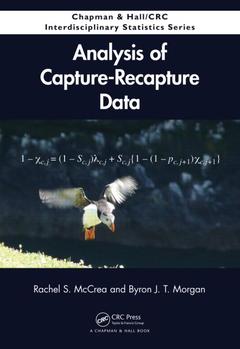Analysis of Capture-Recapture Data Chapman & Hall/CRC Interdisciplinary Statistics Series
Auteurs : McCrea Rachel S., Morgan Byron J. T.

An important first step in studying the demography of wild animals is to identify the animals uniquely through applying markings, such as rings, tags, and bands. Once the animals are encountered again, researchers can study different forms of capture-recapture data to estimate features, such as the mortality and size of the populations. Capture-recapture methods are also used in other areas, including epidemiology and sociology.
With an emphasis on ecology, Analysis of Capture-Recapture Data covers many modern developments of capture-recapture and related models and methods and places them in the historical context of research from the past 100 years. The book presents both classical and Bayesian methods.
A range of real data sets motivates and illustrates the material and many examples illustrate biometry and applied statistics at work. In particular, the authors demonstrate several of the modeling approaches using one substantial data set from a population of great cormorants. The book also discusses which computer programs to use for implementing the models and contains 130 exercises that extend the main material. The data sets, computer programs, and other ancillaries are available at www.capturerecapture.co.uk.
The book is accessible to advanced undergraduate and higher-level students, quantitative ecologists, and statisticians. It helps readers understand model formulation and applications, including the technicalities of model diagnostics and checking.
Introduction. Model Fitting, Averaging, and Comparison. Estimating the Size of Closed Populations. Survival Modeling: Single-Site Models. Survival Modeling: Multi-Site Models. Occupancy Modelling. Covariates and Random Effects. Simultaneous Estimation of Survival and Abundance. Goodness-of-Fit Assessment. Parameter Redundancy. State-Space Models. Integrated Population Modeling. Appendix.
Rachel S. McCrea is a NERC research fellow in the National Centre for Statistical Ecology at the University of Kent.
Byron J.T. Morgan is an Emeritus Professor and honorary professorial research fellow in the School of Mathematics, Statistics and Actuarial Science at the University of Kent. He is also the co-director of the National Centre for Statistical Ecology.
Date de parution : 09-2014
15.6x23.4 cm
Thèmes d’Analysis of Capture-Recapture Data :
Mots-clés :
Capture Recapture Data; Robust Design Model; survival; Herring Gulls; probabilities; Ring Recovery Data; cormack; Data Set; jolly; Capture Recapture Models; seber; CJS Model; model; Estimable Parameters; probability; Capture Probabilities; ring; Recovery Probability; recovery; Recapture Probabilities; models; Soay Sheep; Annual Survival Probability; Posterior Distributions; RJMCMC Algorithm; Marginal Posterior Distributions; Thunnus Alalunga; State Space Models; Small AICc; Parameter Redundancy; UK’s Bird; Sampling Occasion; Reversible Jump Markov Chain Monte; Full Rank Models; Kalman Filter



